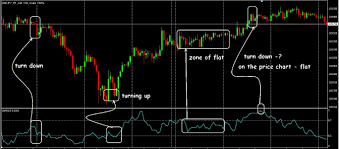Introduction to the Demarker Indicator
The Demarker indicator, also known as DeM, is a technical analysis tool used by traders and financial analysts to measure an asset’s demand and predict future price movements. It was developed by famous technical analyst Thomas DeMark to help traders identify market tops, bottoms, and potential price reversals.
Functioning as a momentum oscillator, the Demarker indicator evaluates the relationship between recent highs and lows within a specific time frame. This enables it to predict price exhaustion and identify overbought or oversold market conditions. For professionals in the financial realm, like stock traders or analysts, understanding the intricacies of this tool can significantly impact their ability to make profitable decisions.
How Does the Demarker Indicator Work?
At its core, the Demarker indicator works by comparing the most recent maximum and minimum price levels of an asset to equivalent levels from a prior period. This comparison reveals the directional bias of the market while highlighting imminent changes in price trends.
Key Characteristics of the Demarker Indicator:
- Oscillator Format: The indicator moves between the values of 0 and 1, with certain versions extending the scale to -100 and 100.
- Boundary Levels: Uses the 0.30 level to indicate oversold conditions and the 0.70 level to signal overbought conditions, highlighting regions where price trend reversals may occur.
- Time Periods: Typically calculated over 14 periods but adaptable to other time frames based on the trader’s preference. Longer time frames produce smoother curves, while shorter ones increase responsiveness.
- Focus on Intraday Data: Unlike the Relative Strength Index (RSI), which considers closing prices, the Demarker indicator emphasizes intraday highs and lows. This unique focus helps reduce distortions caused by erratic price behavior.
Strategy for Using the Demarker Indicator
The Demarker indicator is widely used in combination with other technical analysis tools to corroborate signals and determine optimal entry or exit points. Below are the primary strategies used with DeM:
1. Identify Overbought and Oversold Conditions
When the Demarker curve rises above 0.70, the asset is potentially overbought, signaling a likely downward price correction. Conversely, when the curve dips below 0.30, the asset may be oversold, indicating a possible price increase.
2. Predict Trend Reversals
The Demarker indicator is particularly effective in revealing market tops or bottoms, helping traders identify when to enter or exit strategically.
3. Combine with Other Indicators
While the Demarker indicator excels at forecasting short-term price movements, it is often used alongside tools like Relative Strength Index (RSI) or Bollinger Bands for confirmation of trends.
4. Manage Risk
The Demarker indicator can act as a warning system for price exhaustion, enabling traders to reassess risk exposure during potentially volatile periods.
Practical Example
If a stock sees successive higher intraday highs, resulting in the Demarker value crossing above 0.70, a trader might prepare for a potential trend reversal. Paired with additional indicators showing bearish signals, they could decide to sell the stock before the anticipated price drop.
Strengths of the Demarker Indicator
- Versatility
The Demarker indicator isn’t limited to any specific market or time frame. Its adaptability allows traders to apply it to stocks, commodities, forex, and cryptocurrencies alike.
- Leading Indicator
Unlike many lagging indicators, the Demarker was designed as a leading indicator. This means it attempts to forecast price trends before they occur, giving a competitive edge to those who use it effectively.
- Reduced Distortion
By focusing on intraday highs and lows rather than closing prices, it avoids distortions seen in indicators like the Rate of Change (ROC).
Limitations of the Demarker Indicator
While the Demarker indicator is a valuable tool, it has its limitations.
- Low Signal Frequency
Research indicates that the Demarker generates relatively few signals compared to other indicators, which can be restricting for traders seeking frequent opportunities.
- Questionable Predictive Power
Recent studies, particularly in commodity markets, suggest the Demarker does not always perform as advertised. Many signals fail to predict trend reversals and instead align with the continuation of existing trends.
- Dependency on Other Tools
The Demarker indicator is most effective when used in combination with additional indicators to verify its signals. On its own, it may produce false positives or lack the depth to fully inform trading decisions.
Best Practices for Using the Demarker Indicator
- Combine with Other Tools: Use the Demarker alongside complementary indicators to confirm trends, such as Moving Averages or RSI.
- Explore Different Time Frames: Assess the indicator over both short-term and long-term periods to identify the optimal setting for your trading strategy.
- Validate Signals in Historical Data: Backtest the indicator on historical price data to evaluate its effectiveness before applying it in live trades.
- Risk Management: Always account for the potential of false signals and incorporate appropriate stop-loss measures to mitigate risk.
Is the Demarker Indicator Right for You?
The Demarker indicator is most suitable for traders looking to optimize their entry and exit points with a tool that evaluates short-term market conditions. While it can provide a significant competitive edge when used correctly, it requires thoughtful application and support from additional technical analysis tools.
For financial analysts, stock traders, and investment professionals, the Demarker can become a valuable part of your technical toolkit to assess directional market trends and implement data-driven strategies.
Final Thoughts
The Demarker indicator stands out as a unique tool that offers insight into potential price movements by analyzing intraday highs and lows. It’s a robust solution for identifying overbought or oversold conditions, managing risks, and predicting trend reversals.
However, like any indicator, it’s not flawless. Understanding its strengths and limitations, and combining it with other methods, can help you unlock its full potential. Incorporate the Demarker into your strategy, and leverage its predictive power to make informed trading decisions that align with your investment goals.








